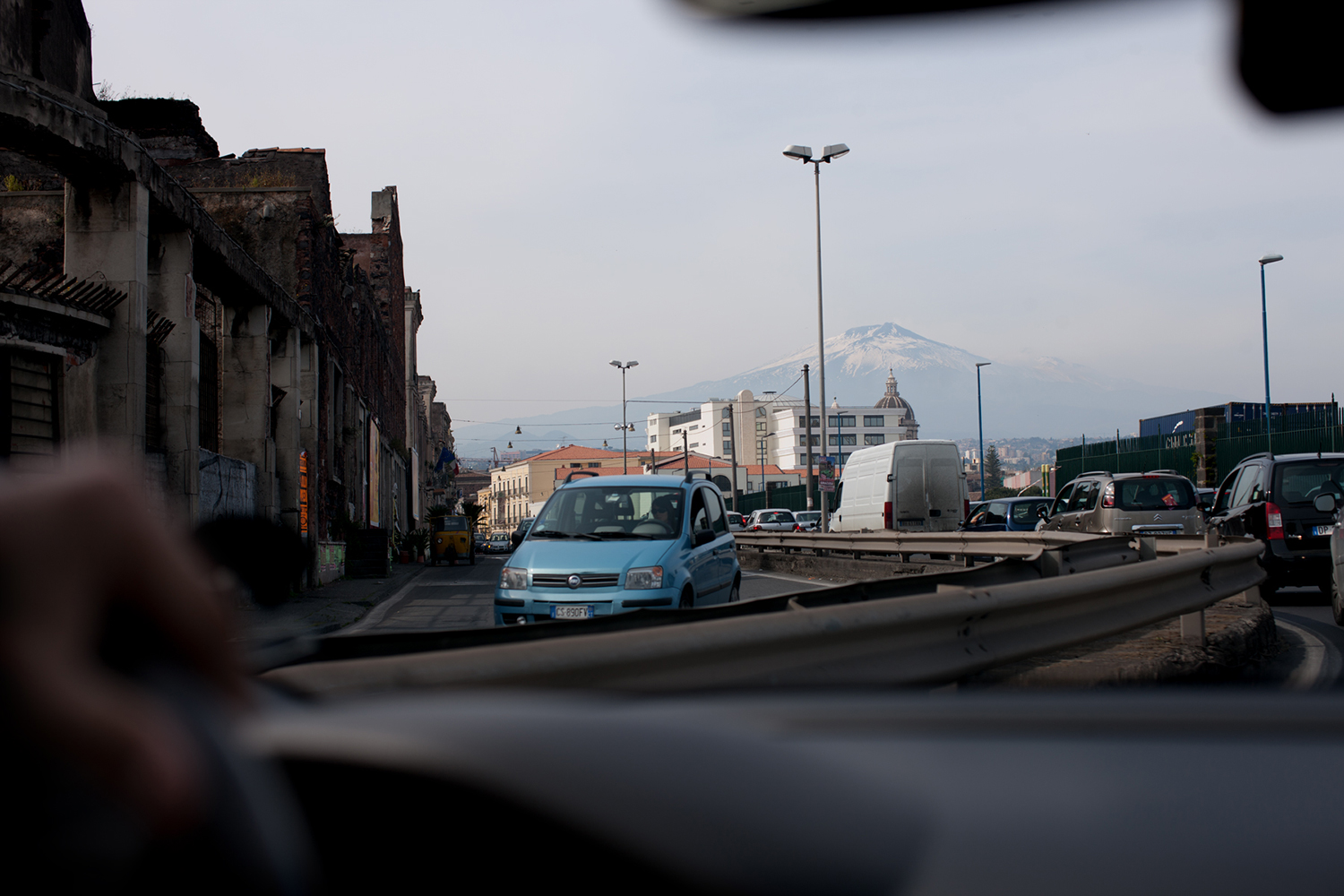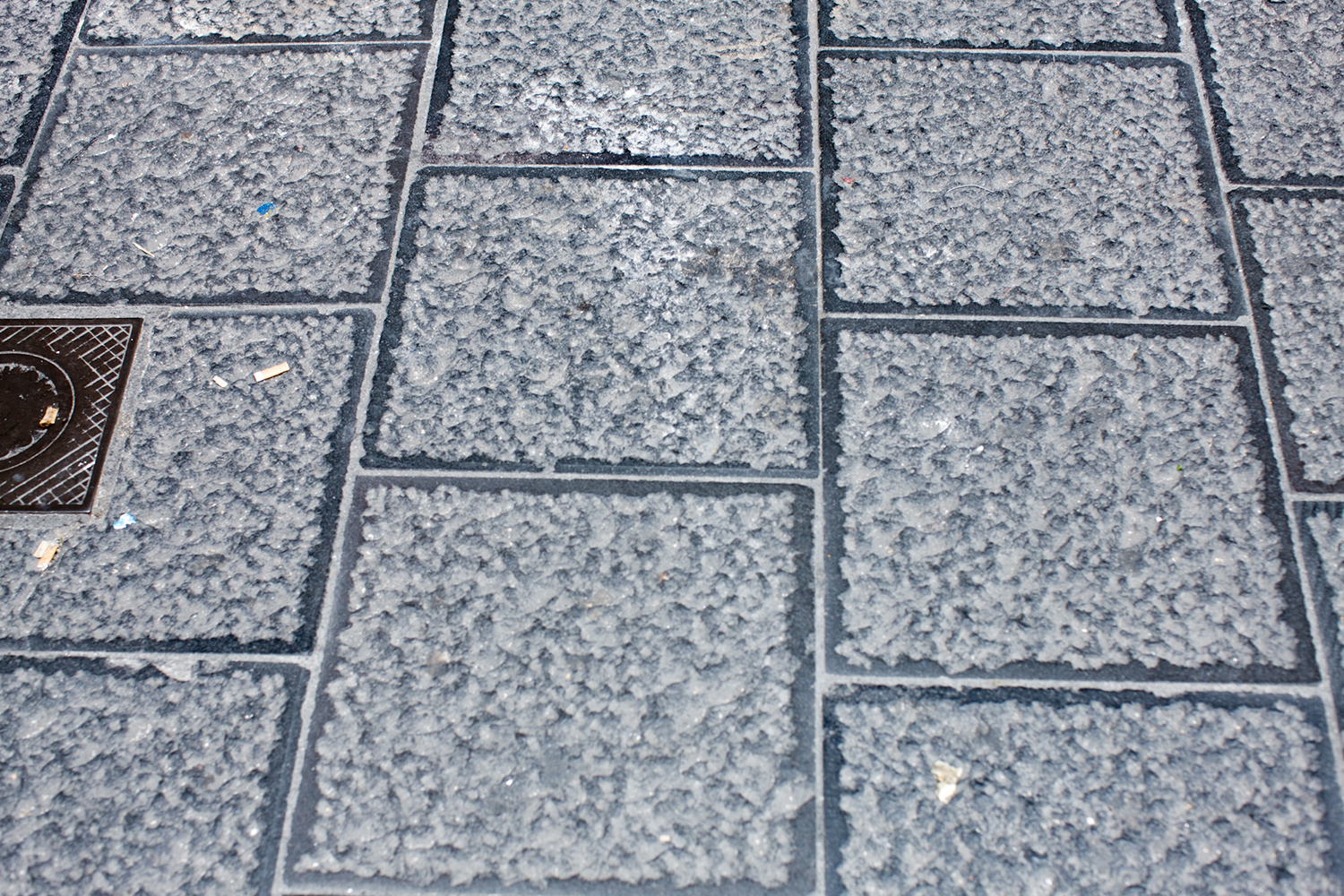Catania 1: Chiosco
Acclimation to Sicily began at the airport in Rome, where for every inch we moved forward in line (it seemed a good chance we might miss our plane), a certain pushy man in weekday attire encroached as if somehow his pushiness might cause us to let him cut in line. When an agent from the airline opened the rope and invited anyone going to Catania to bypass the line, Mr. Pushy shoved past us to get to the counter first.
Along the way to Nick's parents' house in Catania (where we would stay for four nights) I stared out the windshield at the gritty seaside beauty of the town and the frightening looming majesty of the snow-capped live volcano in the background. Etna had erupted just a few months ago (here’s a video) — could this happen during our visit? I gazed everywhere, soaking in the surroundings — but I also did my best to listen to Nick’s descriptions of what we were seeing.
“You see this wall,” he said, “You see how it’s bent? That’s because the sea used to go up that high.
“Look at the sidewalks. You see they’re black? They’re made of lava.” (Scroll above photo.)
“Look over there, see that — it’s a chiosco. They’re only in Catania. It’s a hangout spot, they have amazing drinks.”
Huh? Why’s he talking about Costco, I thought to myself — a little spacey and not quite hearing the part about amazing drinks — as I stared at the volcano, noticed the harbor, wondered about the graffiti, watched squeegee guys attacking windshields without permission, and marveled at details of the many 18th century façades.
We drove onward and up a hill and passed other sights along the way toward the house. Nick described the food plans he had in mind for our three day visit to his hometown — a visit during which I felt so touched by his unrelenting desire to share with me as much as possible. (“Three days is not enough,” he said. “We need at least a month.”)
And for the third or fourth time during our drive, Nick pointed to another little shack and said, “You see? Another chiosco.”
Waking up to this word finally — and realizing that he couldn’t (in Italy) be speaking of the American warehouse store Costco — I asked him, “What’s a chiosco?”
“Have you been listening to me?” he said.
Uh oh, I thought to myself, Not well enough, I guess.
“Sorry,” I said. “I’ve been soaking it all in. Please tell me again. I’m listening.”
“Chiosco,” Nick said, “is a place where you get fruit drinks and other drinks made with soda water and lemon. Chioschi are only in Catania. Nowhere else.”
“That sounds amazing!” I said. “When can we go?!”
--
By the time we arrived at Nick’s parents’ house it was late afternoon and we hadn’t had lunch. There were two types of mozzarella di bufala that Nick had picked up in Campania (the epicenter of the mozzarella world): treccie, braided pieces, firm throughout; and nodini, medium size balls with nearly liquid centers. There was also tomato and basil. The tomatoes were so firm I worried they'd taste unripe, but they were as sweet as the ones you get during a New York summer.
As soon as we were done with lunch, Nick said, “Let’s go. We’ll take the kids.”
“Where to?” I asked.
“To chiosco,” he said.
--
What if you could live in a town teeming with outdoor kiosks that sell the most refreshing and colorful beverages you’ve ever had? Imagine that these drinks only exist at the kiosks of your town, that they are nowhere else, that some of them are hundreds (as in, 200+) years old, and that some are closed all day and open most of the night but for others the schedule is reversed.
The town with these places is Catania — a city of many unique foods and beverages — and the drinks I've described are served at chioschi (Italian pronunciation is kee-oh-sko, it means 1 kiosk; or kee-oh-ski, which means 2 or more kiosks). Only locals go.
Behold my favorite drink, the completo — white as an Oreo's filling and made with almond syrup, anise extract, hand-squeezed lemon juice, and cool seltzer from a built-in tap. The anise arrives as a mere hint, but it's just enough to defend against almond overkill. The lemon brings it all back to earth with refreshing zing. And, as with all of the drinks at chiosco — the strength of the seltzer leaves you pumped and ready for a workout at the gym. Or at least another bibite (beverage).
While beer and coffee are also options at chiosci (and smoothies and Nutella shakes), these drink spots are about soda — sodas that make Coca Cola, Fanta, or even the fancy bottled sodas you can find in the US taste like factory stuff. Drink a manderino and despite its high sugar and artificial color (uh, green tangerine??), it tastes like natural fruit — amplified. Taste a completo and marvel at the strength of its flavors (and at the mastery of the mixer-man). Other choices include orange, tangerine, green tangerine, tamarind, lemon & salt, strawberry, chinotto, pineapple, mint, and coffee. Cost for a drink: one Euro.
By the end of the first day of our visit I was totally obsessed with these places. And by the time we returned to the US, Julia had made a "rule" that I wasn't not allowed to utter the word chiosco. Chiosco. Aha! I can write it. She's too young to access and read this.
Everywhere we drove I noticed (and photographed) kiosks, shacks, sheds, food trucks, mini pick-up trucks with crates of vegetables stacked so high they made me nervous, and newsstands. (Pointing to the different types of places I asked Nick, "Do they have chiosco drinks?" "No," he said.) When we went to bars for breakfast, I wondered why they don't — along with the standard coffee fare — also make chiosco drinks. Some of the chioschi looked like they were closed for good, boarded up to ready for the bulldozer, but when we drove past those ones at night, they were hoppin'.
--
On our way out for dinner that first night, as I steered Nick’s mother’s car through Catania's narrow streets, I witnessed from drivers at every intersection agressive behavior similar to that of the man in the Rome airport: they came at us from all directions and acted as though they would not stop even though they had the stop signs and the red lights. A nonsensical game of chicken.
Also, we went through red lights — though not by choice. We were following Nick and had no map, no phone, no address. If he did it, we had to do it. The next day I asked him to please stop going through red lights. He informed me that those were “pedestrian red lights.”
“How can you tell they’re for pedestrians? All the lights look the same,” I asked. “Don’t worry, I know,” he said. “Yeah, but how do I know?” I asked him. “You don’t,” he said.
And this is the intrigue of Sicily. You have to know stuff. If not for the generosity of our host, I doubt I'd have stopped at a single chiosco during our visit. I also wouldn't have known where to get the best rice balls or pizza or octopus salad because none of the top spots were obvious. But these encounters did occur and it is my duty to report on them here. This piece is about chiosco — and I've made a video featurette for your viewing pleasure. To watch it, click on the photo (below) of Julia and her friend Luce.
Next installment: Catania 2: Pescheria (Fish Market)
--
--
Click photo above for video about the chisochi of Catania.
--
Blu-express Airlines offers inexpensive flights to Catania from many cities in Europe.
The two chiosci featured in the video "Chiosco" are both located at Piazza Vittorio Emanuele III, in Catania.




